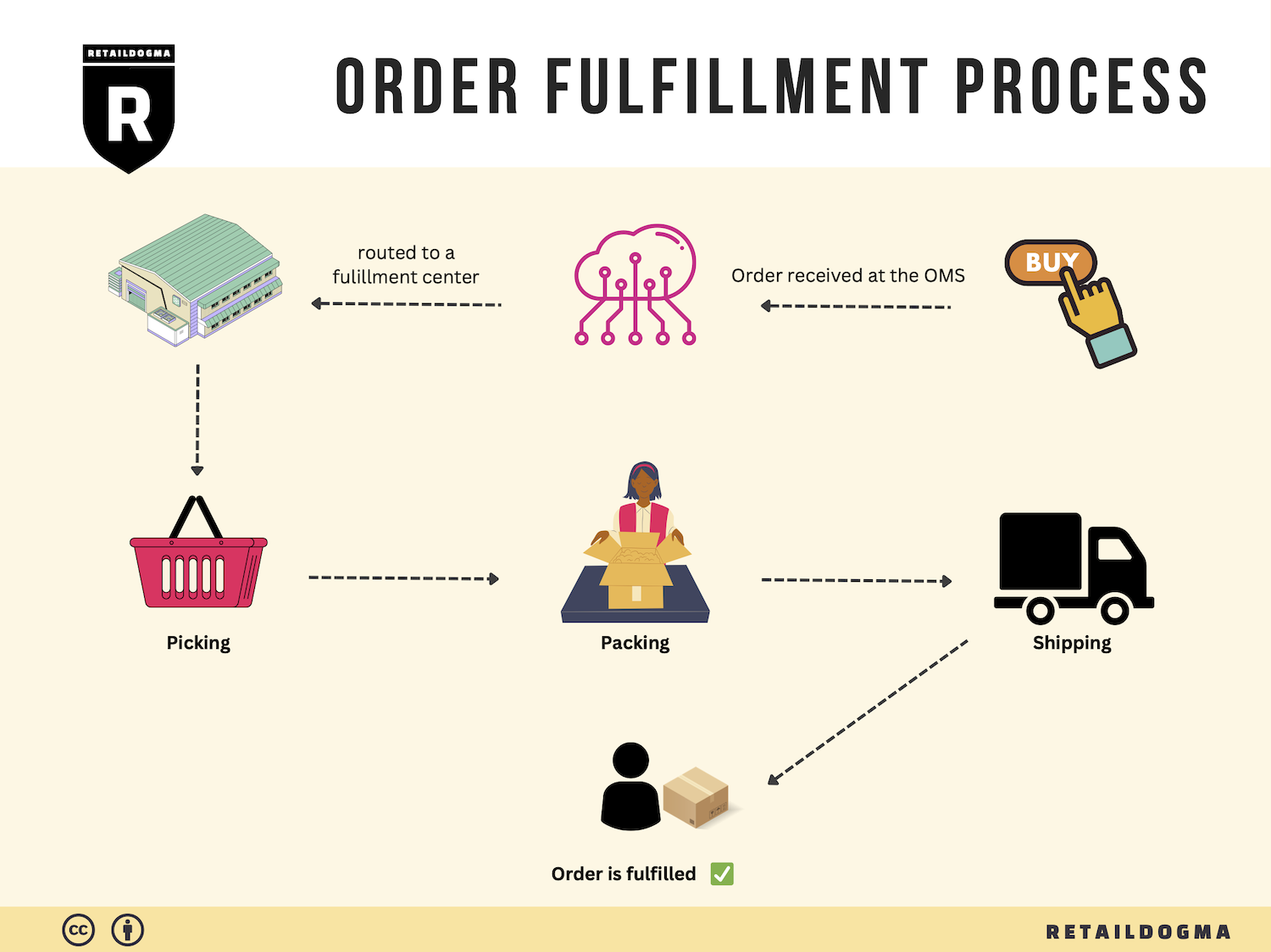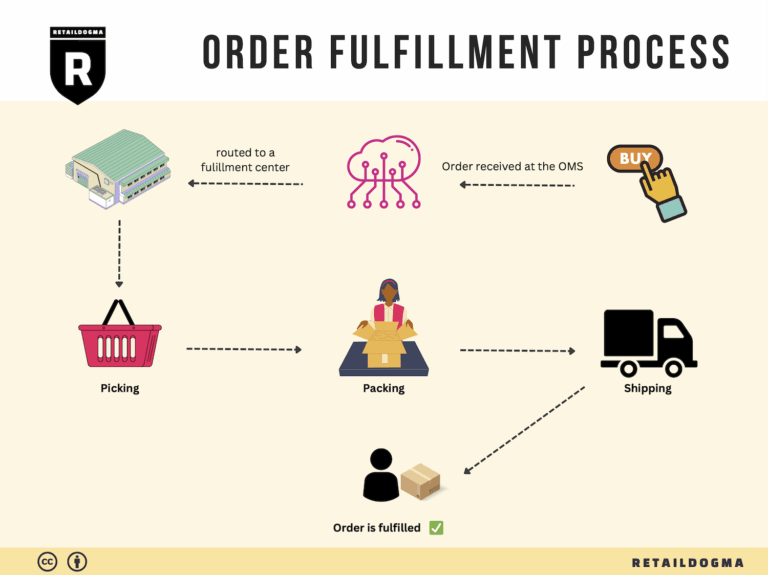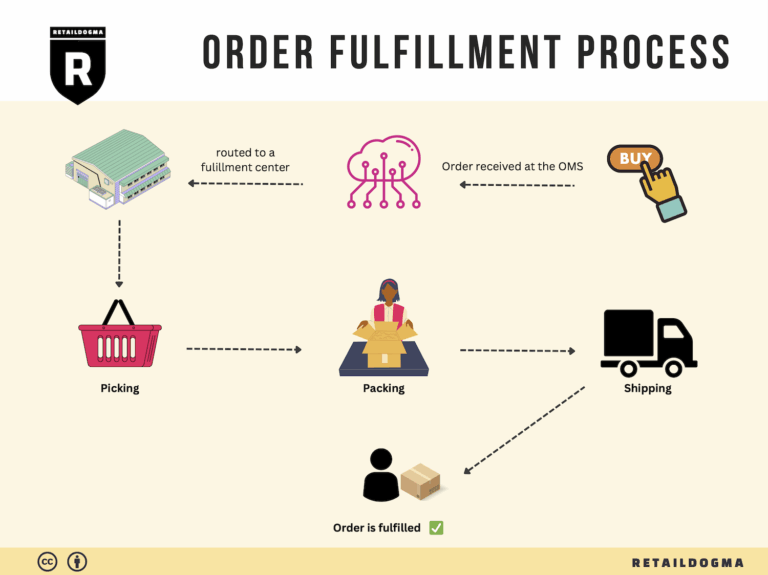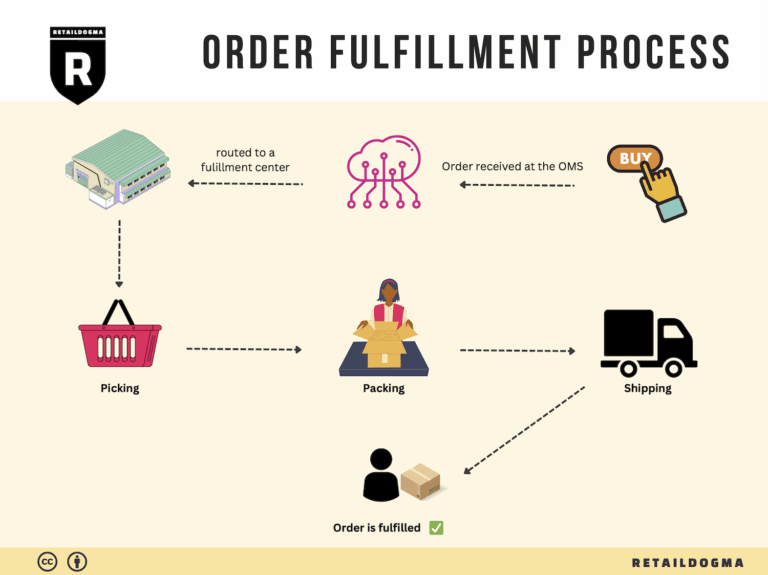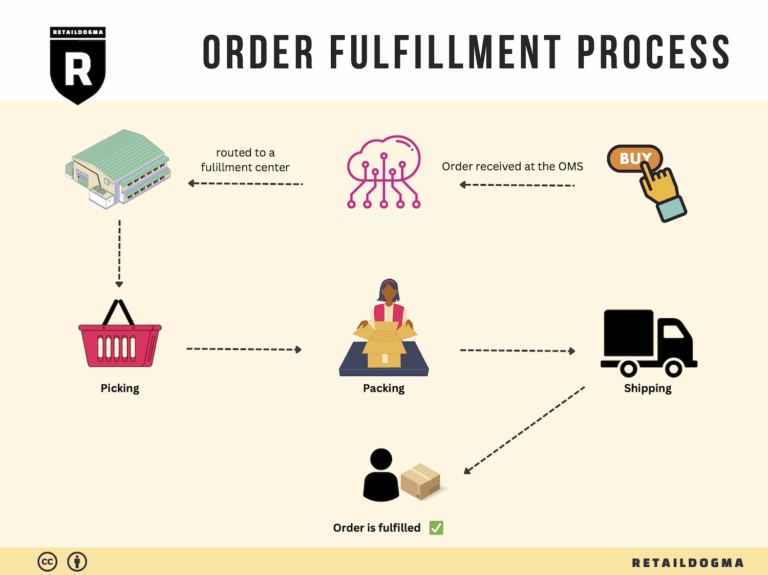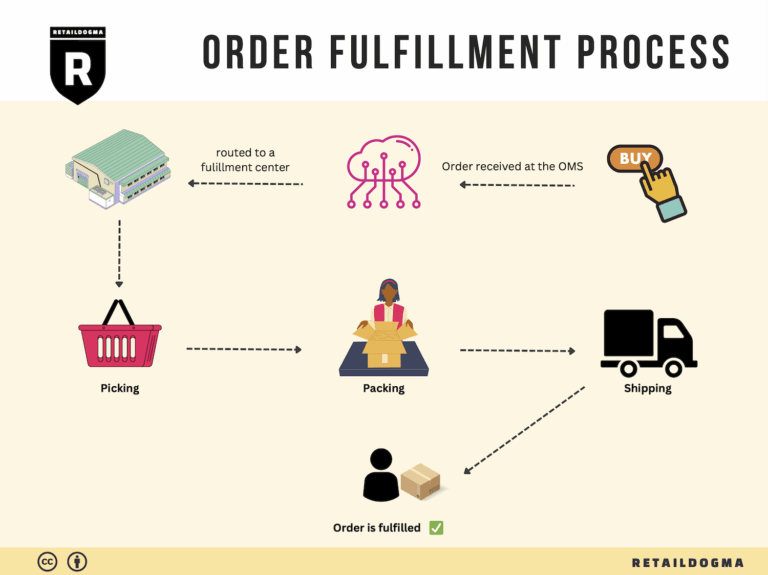How Order Fulfillment Works: A Step-by-Step Guide for Businesses
What is E-commerce Fulfillment? An Introduction for Growing Businesses
Navigating the Challenges of Order Fulfillment
As an e-commerce business owner, you may find yourself grappling with the complexities of packing and shipping orders. The excitement of generating sales can quickly turn into frustration as you face the logistical challenges of getting products to your customers efficiently. This overwhelm can detract from your core business activities, stifling growth and innovation.
Fulfillment is simply the process of getting a product from your inventory to the customer’s doorstep. It encompasses everything from receiving inventory, processing orders, and packing items, to shipping them out and managing returns. For growing businesses, mastering this process is crucial to maintaining customer satisfaction and scaling operations effectively.
In this guide, we will delve into the various fulfillment models available to e-commerce businesses, such as Third-Party Logistics (3PL) and Fulfillment by Amazon (FBA). Each model has its own set of advantages and challenges, and understanding these can help you make informed decisions about which approach best aligns with your business goals.
We will explore the core services offered by fulfillment partners, including inventory management, order processing, and shipping logistics. Knowing what services you need will help you identify the right partner who can meet your specific requirements and support your growth trajectory.
Choosing the right fulfillment partner is a pivotal step in your scaling journey. We will outline key criteria to consider, such as reliability, technology integration, and geographical reach. A well-chosen partner can streamline your operations and enhance your customer experience.
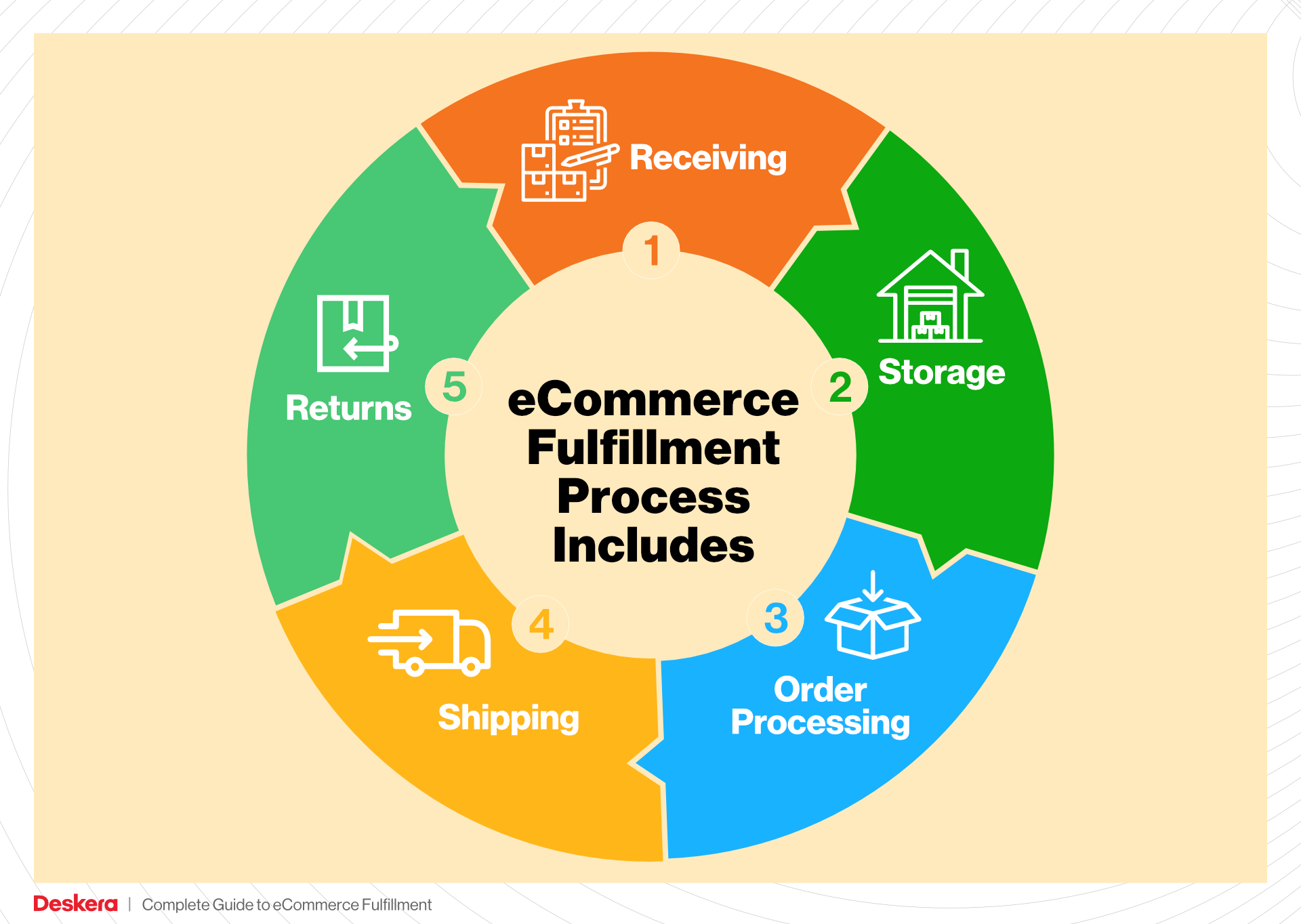
Pricing is another critical aspect we will cover. Understanding the costs associated with different fulfillment models and services will empower you to budget effectively and make strategic decisions that positively impact your bottom line.
Ultimately, this guide aims to equip you with the knowledge and insights needed to make smart decisions about your logistics. By understanding e-commerce fulfillment and its intricacies, you will be better positioned to focus on what truly matters: growing your business and delighting your customers.
What You’ll Learn In This Guide
- What is E-commerce Fulfillment? An Introduction for Growing Businesses
- The Order Fulfillment Process: From ‘Buy’ Button to Customer’s Door
- Comparing Fulfillment Models: In-House vs. 3PL vs. Dropshipping
- A Deep Dive into Amazon FBA: Pros, Cons, and Who It’s For
- Core Services Offered by Fulfillment Centers
- How to Choose a Fulfillment Partner: A 6-Point Checklist
- Understanding Fulfillment Pricing: A Breakdown of Common Fees
- Frequently Asked Questions (FAQs) about Fulfillment
- Conclusion: Is Outsourcing Fulfillment the Right Move for Your Business?
- Important Disclaimer
The Order Fulfillment Process: From ‘Buy’ Button to Customer’s Door
1. Receiving Inventory
The first step in the order fulfillment process is receiving inventory. When products arrive at the fulfillment center, they are unloaded and checked for accuracy against shipping documents. This process involves scanning each item to log its entry into the system, often using Stock Keeping Units (SKUs) to track specific products.
Importance: Proper receiving is crucial because it ensures that the inventory is accounted for and that any discrepancies are addressed immediately. An efficient receiving process minimizes errors that could lead to stock shortages or overages, which can disrupt subsequent steps in fulfillment.
Key Term: SKU (Stock Keeping Unit) – A unique identifier for each product that helps in tracking inventory levels and locations within the warehouse.
2. Warehouse Storage
Once the inventory is received, it is sorted and stored within the fulfillment center. This involves organizing products in a manner that optimizes space and facilitates easy access. Fulfillment centers typically employ various storage strategies, such as dynamic slotting, where items are stored based on demand patterns.
Importance: Effective warehouse storage is vital for maintaining an organized inventory system. It allows for quick retrieval of items during order picking and helps prevent lost products or inefficiencies. The layout and storage systems can significantly influence the speed of the entire fulfillment process.
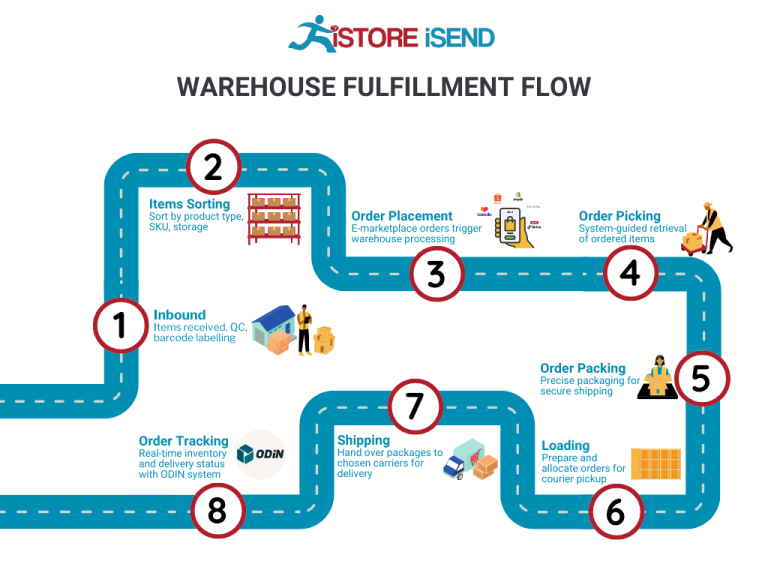
Key Term: Dynamic Slotting – A strategy that involves placing items in storage locations based on their sales velocity and demand, ensuring that frequently ordered items are easily accessible.
3. Order Picking
The next step is order picking, where items are selected from storage based on customer orders. This process typically utilizes picking lists generated by the warehouse management system (WMS), which detail the items needed for each order. In advanced fulfillment centers like Amazon’s, automated systems may assist with this process by bringing storage pods to pick stations.
Importance: Accurate order picking is essential for ensuring that customers receive the correct products. Errors during this stage can lead to returns, customer dissatisfaction, and increased operational costs. Efficient picking processes contribute to faster order fulfillment times, which can improve customer loyalty and retention.
Key Term: Pick List – A document or digital interface that outlines the items and quantities required for fulfilling specific customer orders, guiding warehouse personnel in the picking process.
4. Order Packing
After items are picked, they move to the packing stage. Here, warehouse associates verify the picked items against the order details and prepare them for shipment. This involves placing items into appropriate packaging, ensuring they are secure for transport, and sometimes using automated systems to optimize packaging materials and size.
Importance: The packing process is critical for protecting products during transit. Proper packing reduces the likelihood of damage, which can lead to customer dissatisfaction and increased costs from returns. Additionally, efficient packing processes can help minimize shipping costs by ensuring the right-sized packaging is used.
Key Term: Packaging Optimization – The practice of selecting the most appropriate packaging materials and sizes to minimize waste and shipping costs while ensuring product safety.
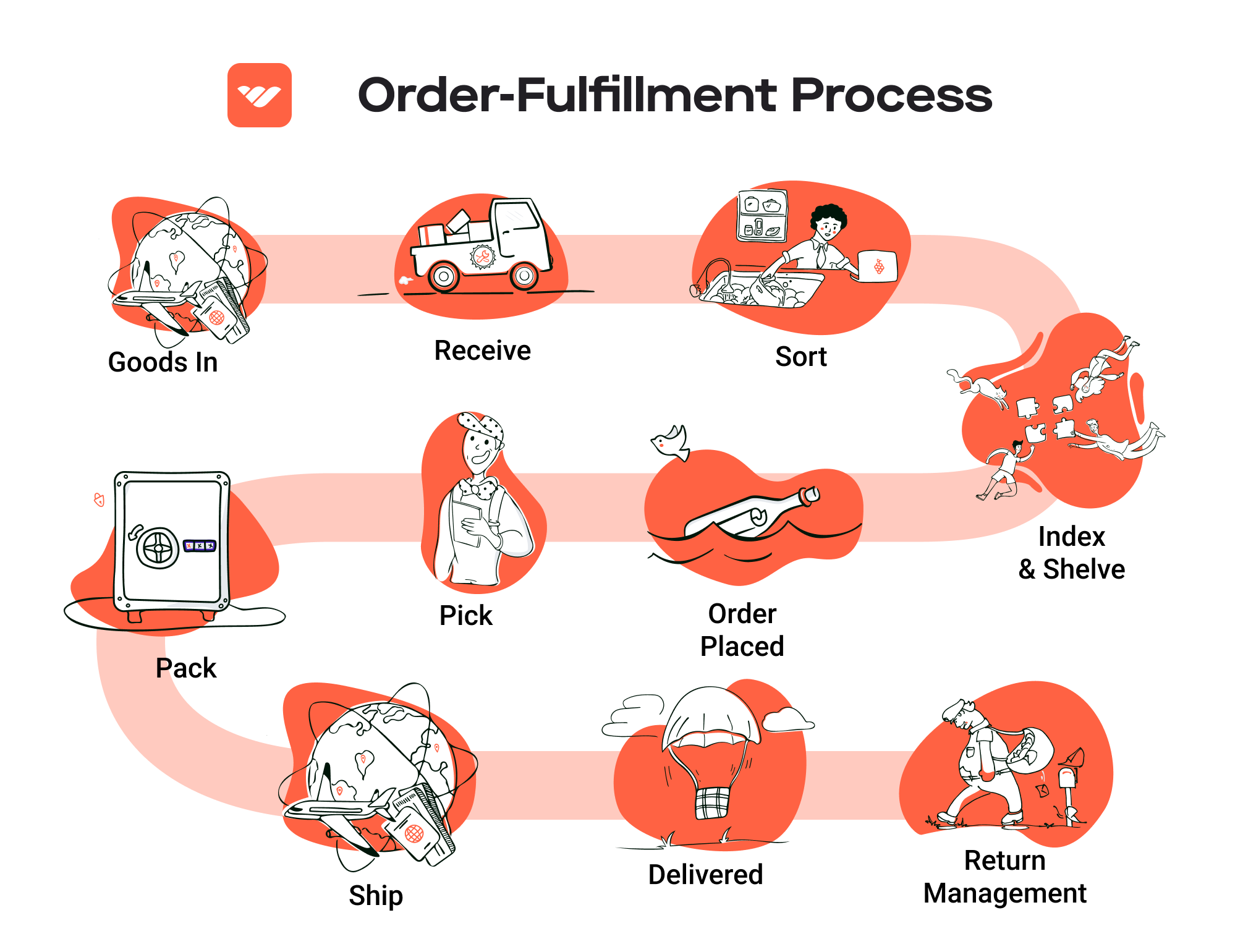
5. Shipping & Delivery
The final step in the order fulfillment process is shipping and delivery. Once packed, orders are labeled and sorted based on their destination and shipping method. Fulfillment centers use advanced systems to manage the shipping logistics, ensuring that packages are dispatched to the correct carriers for timely delivery.
Importance: Timely shipping is crucial for customer satisfaction, especially for e-commerce businesses that promise quick delivery times. Efficient shipping processes can enhance a company’s reputation and encourage repeat purchases. Additionally, effective logistics management can lead to cost savings and improved operational efficiency.
Key Term: Last-Mile Delivery – The final step in the shipping process where packages are transported from the fulfillment center to the customer’s doorstep, often representing the most complex and costly segment of the delivery chain.
By understanding and optimizing each of these steps in the order fulfillment process, e-commerce businesses can improve their efficiency, reduce costs, and enhance customer satisfaction.
Comparing Fulfillment Models: In-House vs. 3PL vs. Dropshipping
Fulfillment Models Overview
Understanding the various fulfillment models is crucial for e-commerce business owners aiming to scale operations efficiently. Each model comes with its own set of advantages and disadvantages, which can significantly impact your logistics strategy, customer satisfaction, and overall business growth. Below is a comparison of three primary fulfillment models: In-House Fulfillment, Third-Party Logistics (3PL), and Dropshipping.
| Model | Who Handles Inventory | Best For (Business Stage) | Key Advantage | Key Disadvantage |
|---|---|---|---|---|
| In-House Fulfillment | The business itself | Established businesses with stable sales | Full control over inventory and fulfillment processes | High overhead costs and resource-intensive |
| Third-Party Logistics (3PL) | A third-party provider | Growing businesses needing scalability | Flexibility and expertise in logistics | Less control over fulfillment process |
| Dropshipping | Suppliers or manufacturers | Startups or businesses with limited capital | Low upfront investment and inventory risk | Lower profit margins and longer shipping times |
In-House Fulfillment
In-house fulfillment refers to the process where a business manages its own storage, picking, packing, and shipping of products directly from its own facilities. This model is typically best suited for established businesses that have stable sales and sufficient resources to manage logistics. One of the key advantages of in-house fulfillment is the complete control it offers over inventory management, order processing, and customer service. Businesses can implement tailored processes that align with their brand values, ensuring a consistent customer experience. However, this model can be resource-intensive, requiring significant investments in warehouse space, staffing, and technology. Additionally, as order volumes grow, the complexities of managing logistics in-house can lead to operational inefficiencies and increased overhead costs.
Third-Party Logistics (3PL)
Third-party logistics (3PL) involves outsourcing logistics operations to specialized providers who handle storage, order fulfillment, and shipping. This model is ideal for growing businesses that need to scale quickly without the burden of managing their own warehouses. A key advantage of using a 3PL provider is the flexibility it offers; businesses can easily adjust their logistics operations in response to changing market conditions or seasonal demand. Furthermore, 3PL providers often possess advanced technology and expertise in supply chain management, which can enhance operational efficiency and reduce shipping times. However, the trade-off is that businesses relinquish some control over the fulfillment process, which can lead to discrepancies in service quality or delays if the 3PL provider does not meet expectations.
Dropshipping
Dropshipping is a fulfillment model where retailers do not hold any inventory but instead transfer customer orders directly to suppliers or manufacturers, who then ship the products directly to the customer. This model is particularly attractive for startups or entrepreneurs with limited capital, as it eliminates the need for upfront investment in inventory. The primary advantage of dropshipping is the reduced financial risk; businesses do not have to invest in stock that may not sell, and they can offer a wider range of products without the overhead associated with managing inventory. However, dropshipping often comes with lower profit margins since the retailer must pay the supplier’s price, and shipping times can be longer, leading to potential customer dissatisfaction. Additionally, quality control can be a challenge, as the retailer has little to no oversight over the product being shipped.
Conclusion
Choosing the right fulfillment model is a critical decision that can influence the scalability and success of an e-commerce business. In-house fulfillment offers control and customization but can be resource-heavy. Third-party logistics provide flexibility and expertise, albeit at the cost of some control. Dropshipping presents a low-risk entry point for new businesses but comes with challenges like lower margins and longer shipping times. Business owners should carefully assess their operational needs, growth potential, and resource availability when selecting the most suitable fulfillment model for their e-commerce strategy.
A Deep Dive into Amazon FBA: Pros, Cons, and Who It’s For
Understanding Fulfillment by Amazon (FBA)
Fulfillment by Amazon (FBA) is a service provided by Amazon that allows sellers to store their products in Amazon’s fulfillment centers. Amazon then takes care of storage, packaging, shipping, and customer service for these products. By leveraging Amazon’s extensive logistics network, sellers can enhance their operations and scale their businesses without the need for substantial investment in their own warehousing and distribution systems.
How FBA Works
-
Inventory Preparation and Shipping: Sellers prepare their products according to Amazon’s guidelines, which include packaging and labeling requirements. They then ship their products to Amazon’s fulfillment centers.
-
Storage: Once the inventory arrives, Amazon stores it in their warehouses. Products are organized and tracked using sophisticated inventory management systems.
-
Order Processing: When a customer places an order for a product fulfilled by Amazon, the fulfillment center automatically receives the order details.
-
Picking and Packing: Amazon uses both human workers and advanced robotics to pick the items from storage. The picked items are packed using optimized processes to ensure efficiency and minimize waste.
-
Shipping: After packing, orders are shipped to customers. Amazon leverages its logistics network, including its own delivery services and partnerships with carriers, to ensure timely deliveries.
-
Customer Service and Returns: Amazon handles all customer service inquiries related to FBA products, as well as managing returns, which simplifies the seller’s workload significantly.
Pros of Using FBA
-
Prime Eligibility: Products fulfilled by Amazon are eligible for Amazon Prime, which can significantly boost sales. Prime members often prefer items that offer faster shipping options, and FBA allows sellers to tap into this lucrative market segment.
-
Increased Customer Trust: Customers tend to trust products that are fulfilled by Amazon due to the reliability associated with Amazon’s brand. This can lead to higher conversion rates and increased sales.
-
Multi-Channel Fulfillment: FBA isn’t limited to just Amazon sales. Sellers can use FBA to fulfill orders from their own websites or other sales channels. This flexibility allows businesses to streamline their logistics while benefiting from Amazon’s robust infrastructure.
-
Scalability: With FBA, sellers can scale their operations without the burden of managing fulfillment logistics. As sales grow, sellers can send more inventory to Amazon without needing to invest in additional warehouse space or staff.
-
Time Savings: By outsourcing fulfillment, sellers can focus on other aspects of their business, such as marketing, product development, and customer engagement. This can lead to improved overall business performance.
Cons of Using FBA
-
High Fees: FBA comes with various fees, including storage fees and fulfillment fees, which can eat into profit margins. Sellers must carefully calculate these costs to ensure that their pricing strategies remain competitive.
-
Strict Inventory Rules: Amazon has stringent guidelines regarding inventory management, including restrictions on certain products and requirements for packaging. Non-compliance can lead to additional fees or even account suspension.
-
Commingling Risks: FBA products may be commingled with other sellers’ inventory in the fulfillment centers. This can lead to issues with quality control and brand integrity, as it may be difficult to trace the origin of products, especially if there are quality concerns.
-
Limited Control: When utilizing FBA, sellers relinquish some control over the fulfillment process. This means that any issues with order accuracy or shipping delays are managed by Amazon, which may not always align with the seller’s standards or expectations.
-
Long-Term Storage Fees: If products remain unsold for an extended period, sellers incur additional long-term storage fees. This incentivizes sellers to manage their inventory efficiently to avoid unnecessary costs.
Who is FBA Best For?
Fulfillment by Amazon is particularly advantageous for:
-
Small to Medium-Sized Businesses: Companies that may not have the resources to manage logistics effectively can benefit from the infrastructure and expertise of Amazon.
-
E-commerce Entrepreneurs: New sellers looking to quickly scale their businesses without the upfront investment in warehousing and logistics can leverage FBA to reach a broader audience.
-
Brands with High Turnover Products: Sellers with fast-moving consumer goods can optimize their sales through FBA by ensuring quick delivery and access to Prime customers.
-
Multi-Channel Sellers: Businesses selling on multiple platforms can streamline their fulfillment processes using FBA, allowing them to maintain consistent inventory across channels.
-
Sellers Looking to Expand into New Markets: FBA allows sellers to take advantage of Amazon’s global reach and logistics capabilities, making it easier to enter new markets without significant investment.
In conclusion, Fulfillment by Amazon provides a powerful solution for e-commerce businesses looking to enhance their fulfillment capabilities and scale their operations efficiently. However, it is essential for sellers to weigh the benefits against the potential drawbacks to determine if FBA aligns with their business goals and operational strategies.
Core Services Offered by Fulfillment Centers
Inventory Management & Warehousing
Inventory management and warehousing are fundamental services provided by fulfillment centers. This process involves receiving, storing, and tracking products until they are ready for shipment. Upon arrival at the fulfillment center, products are carefully inspected, logged into inventory management systems, and allocated specific storage locations. Advanced technology, such as barcode scanning and RFID tagging, is often employed to monitor inventory levels in real-time.
Benefits:
Effective inventory management helps businesses maintain optimal stock levels, reducing the risk of overstocking or stockouts. This is crucial for cash flow management and ensuring that customer demand is met promptly. Additionally, organized warehousing enhances order accuracy and speeds up the picking process, allowing e-commerce businesses to fulfill orders quickly and efficiently. By outsourcing these functions to a fulfillment center, businesses can focus on core activities such as marketing and product development, rather than the complexities of inventory management.
Pick and Pack Services
Pick and pack services are vital components of the order fulfillment process. Once an order is placed, fulfillment centers retrieve the ordered items from their storage locations—a process known as picking. After items are picked, they are packed into shipping boxes or containers, ensuring they are secure for transport. Many fulfillment centers utilize automated systems to streamline this process, reducing human error and increasing efficiency.
Benefits:
This service significantly enhances operational efficiency. By leveraging automated picking systems, fulfillment centers can reduce the time it takes to fulfill orders, thus improving overall delivery speed. This is particularly beneficial for e-commerce businesses that thrive on quick turnaround times to satisfy customer expectations. Moreover, professional packing ensures that products arrive at their destination in perfect condition, reducing the likelihood of returns due to damage. Ultimately, efficient pick and pack services lead to higher customer satisfaction and repeat business.
Kitting and Assembly
Kitting and assembly are additional services that fulfillment centers provide to streamline the product offering for e-commerce businesses. Kitting involves assembling multiple products into a single package or kit before shipping. This can include bundling items that are often purchased together or preparing promotional packages. Assembly services may also involve putting together components of a product before it is shipped to the customer.
Benefits:
Kitting and assembly services allow businesses to offer unique product bundles that can enhance customer value and drive sales. By outsourcing these tasks to fulfillment centers, businesses can save time and labor costs associated with assembling products in-house. This service also allows for customization and flexibility in product offerings, enabling sellers to respond swiftly to market trends or customer preferences. Ultimately, kitting and assembly can lead to increased average order value and improved customer engagement.
Returns Management (Reverse Logistics)
Returns management, or reverse logistics, is a critical service provided by fulfillment centers that deals with the processing of returned goods. This involves receiving returned items, inspecting them for damage, restocking inventory, and managing the necessary paperwork. A well-structured returns management process can significantly enhance customer satisfaction and loyalty.
Benefits:
Efficient returns management is essential for maintaining customer trust and satisfaction. A streamlined process ensures that returns are handled swiftly, minimizing inconvenience for the customer. It also allows e-commerce businesses to quickly restock items and recover losses from returns, thus optimizing inventory levels. Moreover, effective reverse logistics can provide valuable insights into product quality and customer preferences, enabling businesses to make informed decisions regarding product offerings and marketing strategies. By outsourcing returns management to a fulfillment center, businesses can focus on growth while ensuring that the returns process is handled professionally and efficiently.
In conclusion, leveraging the core services offered by fulfillment centers can significantly enhance the operational efficiency and scalability of e-commerce businesses. From managing inventory and expediting order fulfillment to providing specialized services like kitting and handling returns, fulfillment centers play a pivotal role in modern e-commerce logistics. By partnering with a reliable fulfillment center, businesses can streamline their operations, reduce costs, and ultimately drive sales growth.
How to Choose a Fulfillment Partner: A 6-Point Checklist
Location & Warehouse Network
Importance:
The geographic location of your fulfillment partner’s warehouses is crucial for minimizing shipping times and costs. A partner with a strategically located warehouse network can help you reach your customers faster, which is especially important for businesses that promise quick delivery.
Questions to Ask:
– Where are your warehouses located, and how do they align with my customer base?
– What is your average shipping time to major metropolitan areas?
– Do you have warehouses in multiple regions to optimize shipping costs?
Technology & Integrations
Importance:
A robust technological framework is essential for efficient order processing, inventory management, and tracking. Your fulfillment partner should offer integrations with your e-commerce platform to facilitate seamless data exchange and real-time updates.
Questions to Ask:
– What technology do you use for order management, and how does it integrate with my e-commerce platform?
– Can you provide real-time inventory tracking and updates?
– How do you handle order processing and returns through your technology?
Specializations (e.g., cold storage, oversized items)
Importance:
Depending on the nature of your products, you may require specialized services. For instance, if you sell perishable goods, a partner with cold storage capabilities is essential. Similarly, businesses dealing with oversized or fragile items need fulfillment centers equipped to handle such products safely.
Questions to Ask:
– What types of products do you specialize in handling?
– Do you have specific facilities for temperature-sensitive or oversized items?
– How do you ensure the safety and integrity of specialized products during storage and shipping?
Scalability & Capacity
Importance:
As your business grows, your fulfillment needs will change. Your partner should be able to scale operations up or down based on your current demand. This flexibility is vital for managing seasonal fluctuations and unexpected surges in orders without compromising service quality.
Questions to Ask:
– How do you handle fluctuations in order volume, such as during peak seasons?
– What is your capacity for scaling operations, and how quickly can you adapt to increased demand?
– Are there any limitations on the types of products or volumes you can handle?
Pricing and Contracts
Importance:
Understanding the pricing structure is essential to ensure that it aligns with your budget and financial projections. Transparency in pricing helps avoid hidden fees that could erode your profit margins.
Questions to Ask:
– Can you provide a detailed breakdown of your pricing model, including storage, picking, packing, and shipping fees?
– Are there any additional charges that I should be aware of?
– What are the terms of the contract, and how flexible are they if my needs change?
Customer Support & Reviews
Importance:
Effective communication and support are critical for resolving issues quickly and maintaining operational efficiency. A partner with a strong customer support system can help address problems before they escalate.
Questions to Ask:
– What customer support channels do you offer (e.g., phone, email, chat)?
– How responsive is your support team, and what are your average response times?
– Can you provide references or testimonials from other clients in my industry?
Conclusion
Choosing the right fulfillment partner is a pivotal decision that can significantly impact your e-commerce business’s efficiency and customer satisfaction. By considering these six critical points and asking the right questions, you can identify a partner that not only meets your current needs but also supports your growth strategy. Remember, the goal is to find a partner who aligns with your business values and can adapt as your business evolves.
Understanding Fulfillment Pricing: A Breakdown of Common Fees
Initial Setup Fees
When businesses first engage with an Amazon fulfillment center, they may encounter initial setup fees. These fees typically cover the costs associated with onboarding, including account setup and integration with the seller’s existing systems. The amount can vary based on the complexity of the integration, the number of products to be listed, and any necessary training for using the fulfillment system.
To calculate these fees, fulfillment centers often assess the time and resources required to complete the setup process. For new sellers, understanding these costs upfront can help in budgeting and planning for the transition to using Amazon’s Fulfillment by Amazon (FBA) services.
Receiving Fees
Receiving fees are charged when your inventory arrives at the fulfillment center. These fees cover the labor and equipment costs associated with unloading, inspecting, and storing your products. The calculation of receiving fees can vary based on the volume and type of products being delivered.
For instance, if you send a large shipment, the receiving fee might be lower per unit than for smaller shipments due to economies of scale. Sellers should be aware that any discrepancies in the shipment (like missing items) can lead to additional administrative fees, so it’s crucial to ensure accurate delivery documentation.
Storage Fees (per pallet/bin)
Storage fees are incurred for keeping your products in the fulfillment center. These fees are typically calculated on a per-pallet or per-bin basis and can vary depending on the time of year. Amazon often charges higher storage fees during peak seasons, such as the holiday period, when demand for warehouse space increases.
To calculate storage fees, fulfillment centers will assess the total space your products occupy. This means that sellers should regularly monitor their inventory levels and consider optimizing their stock to avoid excessive storage costs. Additionally, understanding the layout and organization of the fulfillment center can help in better inventory management.
Pick & Pack Fees (per item/order)
Pick and pack fees are charged for the labor involved in retrieving items from storage, packing them for shipment, and preparing them for delivery. This fee can vary based on the complexity of the order and the type of products being handled. For example, bulky items may incur higher fees due to the additional handling required.
Fulfillment centers often charge a flat fee per item picked, along with an additional fee for each order packed. To gain a clearer picture of these costs, sellers should analyze their average order size and product types. This analysis will help in forecasting fulfillment costs and identifying opportunities for optimizing order fulfillment processes.
Shipping Fees
Shipping fees are one of the most critical components of fulfillment pricing. These fees cover the cost of transporting your products from the fulfillment center to the customer. Shipping fees can vary widely based on several factors, including the destination, shipping speed, and the size and weight of the package.
Fulfillment centers usually calculate shipping fees using a combination of flat rates and variable rates depending on the carrier used. For sellers using the FBA program, Amazon’s negotiated shipping rates can often lead to cost savings compared to retail shipping options. Sellers should evaluate their shipping strategies regularly and consider how different shipping options impact overall fulfillment costs.
Tips for Getting an Accurate Quote
-
Detail Your Inventory: Provide a comprehensive list of your products, including dimensions, weights, and any special handling requirements. The more detailed your inventory information, the more accurate the quote will be.
-
Understand Your Needs: Be clear about your fulfillment needs, including expected order volumes, seasonal fluctuations, and specific shipping requirements. This helps fulfillment centers tailor their services to your business.
-
Request Itemized Quotes: Ask for detailed quotes that break down each fee type. This transparency will help you understand the cost structure and identify areas where you can optimize expenses.
-
Negotiate Terms: Don’t hesitate to negotiate terms with fulfillment centers, especially if you anticipate a high volume of orders. Many centers may offer discounts for long-term commitments or larger volumes.
-
Review Regularly: Fulfillment costs can change over time due to various factors, including market demand and operational changes. Regularly reviewing your fulfillment strategy and costs can help you stay competitive and profitable.
By understanding these common fulfillment pricing models and following these tips, e-commerce business owners can effectively manage their logistics costs and optimize their operations for scaling success.
Frequently Asked Questions (FAQs) about Fulfillment
1. What is the PIT2 Amazon Fulfillment Center?
The PIT2 Amazon Fulfillment Center is a facility located in Imperial, Pennsylvania (postal code 15126), dedicated to processing and fulfilling orders placed on Amazon. This center plays a crucial role in the Fulfillment by Amazon (FBA) program, where sellers send their inventory to Amazon, allowing the company to handle storage, order processing, packing, and shipping.
2. How does the order fulfillment process work at PIT2?
The order fulfillment process at PIT2 involves several key steps:
– Inventory Receiving: Products are received and logged into the system.
– Inventory Storage: Items are stored in designated locations within the warehouse, tracked using barcode scanning.
– Order Processing: When a customer places an order, the fulfillment center receives and processes it.
– Order Picking: Associates or robots pick the items from the storage area.
– Order Packing: Picked items are packed securely for shipping.
– Order Shipping: Packages are labeled and sorted for delivery to customers.
3. What are the advantages of using Amazon Fulfillment Centers like PIT2?
Utilizing fulfillment centers such as PIT2 offers several benefits for e-commerce businesses:
– Speed: Orders are processed and shipped quickly due to Amazon’s advanced logistics and technology.
– Scalability: Sellers can easily scale their operations without needing to invest in their own warehousing and logistics.
– Customer Service: Amazon handles customer inquiries and returns, allowing sellers to focus on their core business.
– Global Reach: Access to Amazon’s extensive distribution network ensures wider market reach.
4. What is the difference between a warehouse and a fulfillment center?
While both warehouses and fulfillment centers are used for storage, they serve different purposes:
– Warehouse: Primarily focuses on storing goods for an extended period. It may not handle order processing or shipping.
– Fulfillment Center: Specializes in the order fulfillment process, including picking, packing, and shipping items directly to customers, often with a focus on speed and efficiency.
5. How much do fulfillment services cost at Amazon?
The cost of fulfillment services at Amazon varies based on several factors, including:
– Storage Fees: Charged monthly based on the volume of inventory stored.
– Fulfillment Fees: Charged per unit based on the size and weight of the item being shipped.
– Additional Services: Costs may apply for services like labeling, returns processing, and long-term storage. Sellers should review Amazon’s FBA fee schedule for detailed pricing.
6. What is a 3PL and how does it relate to fulfillment?
A 3PL, or third-party logistics provider, is a company that provides outsourced logistics services, which can include warehousing, fulfillment, and shipping. While Amazon’s fulfillment centers operate as a proprietary solution (FBA), some businesses may choose to work with 3PLs for more customized logistics solutions or if they sell on multiple platforms outside of Amazon.
7. Can I track my inventory at the PIT2 fulfillment center?
Yes, Amazon provides tools and resources for sellers to track their inventory levels and order statuses through the Seller Central platform. This allows businesses to monitor stock levels, view pending orders, and manage their fulfillment processes effectively.
8. What types of products can I send to PIT2 for fulfillment?
PIT2 accepts a wide range of products for fulfillment, but there are restrictions on certain items. Generally, sellers can send non-perishable goods, consumer products, and household items. However, hazardous materials, perishables, and certain restricted categories cannot be stored or fulfilled through Amazon’s centers. It’s important to review Amazon’s guidelines on eligible products.
9. How does Amazon ensure the accuracy of order fulfillment at PIT2?
Amazon employs a combination of technology and processes to ensure order accuracy, including:
– Barcode Scanning: Each item is scanned at various stages to confirm its location and ensure the correct item is picked.
– Automated Systems: Robots and automated systems assist in the picking and packing processes, reducing human error.
– Quality Control Checks: Final checks are performed before shipping to ensure that the correct items are packed and labeled.
10. What should I do if there’s an issue with my order fulfillment at PIT2?
If you encounter issues with order fulfillment at PIT2, such as missing inventory or incorrect shipments, you should contact Amazon Seller Support through the Seller Central platform. They provide assistance and support for resolving fulfillment-related issues, including investigations and claims for lost or damaged inventory.
Conclusion: Is Outsourcing Fulfillment the Right Move for Your Business?
Evaluating the Advantages of Outsourcing Fulfillment
Outsourcing fulfillment can be a transformative decision for e-commerce businesses looking to scale effectively. By leveraging a fulfillment service, such as those offered by Amazon’s network of fulfillment centers, businesses can unlock several key benefits that drive operational efficiency and enhance customer satisfaction.
Firstly, time savings are one of the most significant advantages of outsourcing fulfillment. Managing inventory, processing orders, and handling shipping logistics can be time-consuming tasks that detract from core business activities. By partnering with a fulfillment center, you free up valuable time that can be redirected towards strategic initiatives, such as marketing and product development.
Secondly, scalability is essential for growing businesses. As demand fluctuates, having a reliable fulfillment partner allows you to adapt quickly without the need for significant investments in infrastructure or additional staff. This flexibility ensures that you can meet customer expectations during peak seasons or promotional events, enhancing your brand’s reputation and customer loyalty.
Moreover, outsourcing fulfillment brings expertise to your operations. Fulfillment centers employ advanced technologies and streamlined processes that enhance accuracy and speed. This expertise not only improves order processing times but also reduces errors, resulting in higher customer satisfaction rates.
However, it’s crucial to choose the right fulfillment partner to support your growth strategy. Consider factors such as location, technology integration, and service offerings to ensure alignment with your business needs.
Next Steps
As you contemplate whether outsourcing fulfillment is the right move for your business, take the time to audit your current shipping processes. Assess your operational challenges, inventory management capabilities, and customer feedback. This evaluation will provide clarity on whether a fulfillment partner can help you achieve your growth objectives. Don’t hesitate to reach out to potential partners to explore how they can add value to your e-commerce operations and help you scale effectively.
Important Disclaimer
⚠️ Important Disclaimer
The information in this guide is for educational purposes. Fulfillment services, pricing, and platform features change frequently. Always conduct your own due diligence and consult with providers directly before making business decisions.
